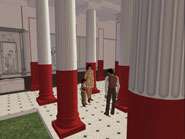Visit Pompeii with the Victorians in Second Life

(������ƵOrg.com) -- A 3D recreation of a Roman house in Pompeii has been built in the virtual world Second Life by Dr Shelley Hales and Dr Nic Earle from the University of Bristol.
The virtual villa is a recreation of the Pompeian Court, a life-size replica of a house in Pompeii which was built inside the Crystal Palace.
In 1936, a huge fire destroyed the Palace which had been a feature on the south London landscape since 1854. Lost with the massive iron and glass superstructure were the displays inside, in particular a series of Fine Arts courts which used reconstruction to show the artistic and architectural achievements of past epochs, from Egypt to the Renaissance. Amongst them was the Pompeian Court, a life-size replica decorated with paintings traced from the wall frescoes uncovered in the city’s ruins.
The virtual model of the Court, built by Dr Shelley Hales and Dr Nic Earle, brings together a digitised collection of the paintings displayed in the Court as well as an archive of the guidebooks and press reviews which described it.
Working with researchers, community groups, school and undergraduate students, Dr Hales and Dr Earle have designed ways of bringing the model alive for users. Through their online avatars, visitors can explore the house alone, join guided tours, meet other visitors, take part in learning activities, or even interact with (virtual) Victorian and Pompeian inhabitants.
Dr Hales said: “The model helps us to compare the strategies the Victorians used to build, inhabit and engage audiences with their immersive Pompeian environment with the techniques made possible by the technology at our disposal today.
“To mark the launch of the project on Wednesday, we’d like to invite people to log on and visit the Pompeian Court online, join in the celebrations and find out more about the project.”
A 3D recreation of a Roman house in Pompeii, built in the virtual world Second Life, will be unveiled at a joint online and real world event today at 1pm (UK Time). To find out how to take part, please read the instructions at:
Provided by University of Bristol















